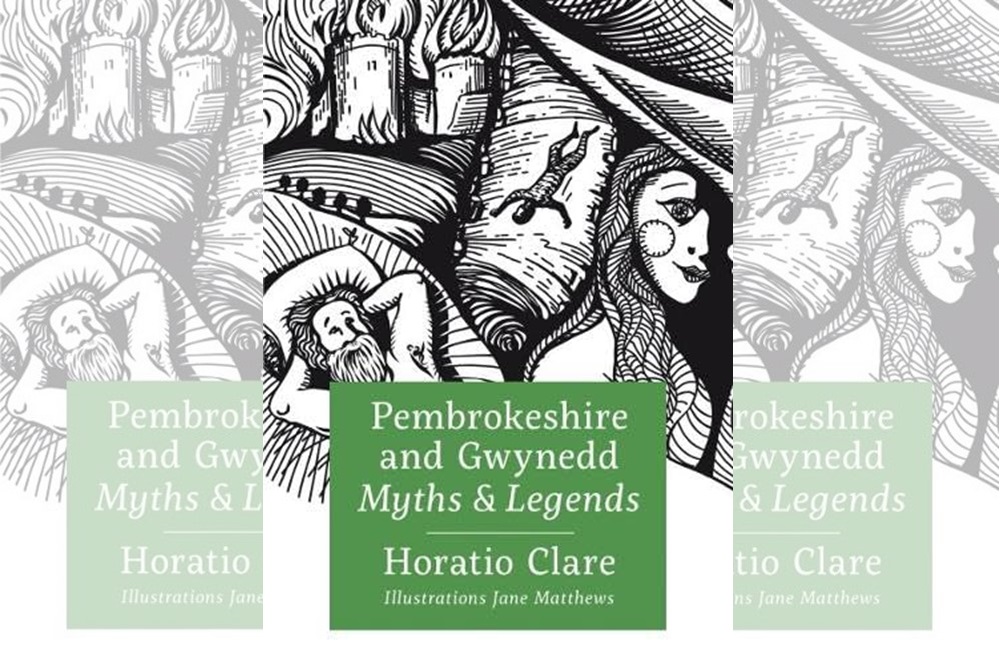Book review: Pembrokeshire and Gwynedd Myths and Legends by Horatio Clare

Elena Gower
Last summer I spent 8 weeks reading Horatio Clare’s entire back catalogue. And on those slow sunny afternoons in the garden, I was taken around the world and back again.
From his childhood home on a sheep farm in South Wales, to riding the rocking, rolling waves of international waters in Down to the Sea in Ships and colder seas still in Icebreaker, he guided me and kept me company.
I flew on the wings of birds in Greece and Bulgaria in Orison for a Curlew and accompanied A Single Swallow across Africa.
I journeyed through 18th century Germany in the company of Clare and J.S. Bach and talked to wild insects.
All the while being entertained and thoroughly enthralled by Horatio’s colourful writing, not least in my favourite book, Truant, which includes his hiding in French freight trains in the middle of the night and meeting complex characters in a Chelsea pub.
In addition to travel writing, Horatio Clare has also written many re-tellings of old folk tales from the Mabinogion, such as The Prince’s Pen which imagines the tale of Lludd and Llefelys in a more modern setting.
Supernatural
Pembrokeshire and Gwynedd Myths and Legends follows on from Clare’s Brecon Beacons Myths and Legends, and contains half a dozen short stories that “bring to life the extensive history and supernatural mystery that resides in these beautiful landscapes” (to quote the blurb).
These short stories include the premonitions of a witch named Tanglwyst, an unexpected meeting between two perfect strangers near Cricieth Castle and, in “Eleanor’s Gyrfalcon” we meet a bird of prey which “in case you don’t know is a huge, badass white falcon, massively bigger than the biggest kind of falcon you have here, which are Peregrines”.
I’d like for you to properly discover the rest for yourself.
Love of the sea
The first short story, “An Ape of Barbary,” further proves Horatio Clare’s love for the sea, detailing Satan (the Ape’s) journey from his native land to the unpredictable hellhole that he believes Wales to be, and his intent on escaping by any means necessary.
I can imagine it very difficult for a Welsh writer to describe his homeland as “that swamp of the Damned.”
Honest account
Nevertheless, it is a very honest account of an outsider’s perspective adapting to a foreign landscape, trying to blend in with its inhabitants, taking note of the peculiar habits of mankind and disagreeing with their treatment of other animals.
His experience of being tortured into becoming a killing machine and a thing of terror for his master’s pleasure is uncomfortable. It is as if the reader’s teeth are the one’s biting, clawing, and gnawing.
Wisdom
An interesting aspect of this story are the many words of wisdom planted in the form of sentences beginning with “so it may be seen.”
Such as: “no living thing may be counted fortunate until we rest among others in love, with great misfortune overcome and adventures accomplished safely.”
Ray of starlight
The third story, my personal favourite, is Princess Nest’s experience of being a beauty, a ray of starlight in the middle of men’s ugly game of war.
She describes her life as being exhausting. “It doesn’t matter how tough you are, it will get to you, being a shiny coin, being a counter on the great board of men’s games.”
Especially exhausting as she, above the noblemen, is the only one to see sense and strategy amidst their chaos.
The Shetland-based artist Jane Mathews illustrates the stories not with black ink but green, underlining that these are tales of the countryside. Green landscapes like intricate tapestries of these beautiful counties.
She has a keen eye for detail and uses lines and patterns to further intrigue us at the beginning of every chapter as well as the bold and animated cover art full of life and expression.
These stories have been passed down from generation to generation. Through hills and valleys, churches and meadows, public halls and marketplaces, the people of Pembrokeshire and Gwynedd have probably heard the stories from their particular patch time and time again.
Not like this. Horatio Clare has a natural gift for storytelling and for gathering tales as old as time and presenting them with a silver ribbon for the future.
Words flow through him like the Cleddau and the Conwy, lifting him up to a place among Welsh storytellers as high as Aran Fawddwy.
Pembrokeshire and Gwynedd Myths and Legends is published by Graffeg and is available from all good bookshops.
Support our Nation today
For the price of a cup of coffee a month you can help us create an independent, not-for-profit, national news service for the people of Wales, by the people of Wales.




